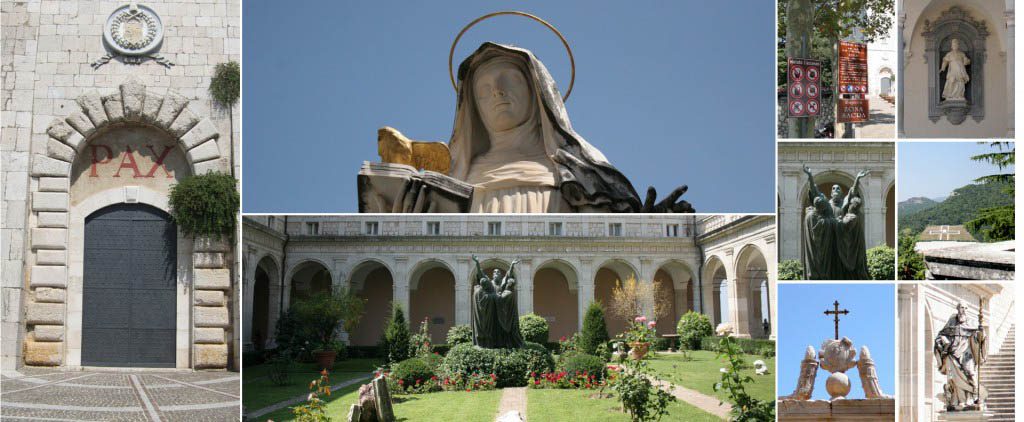How the
Abbey of Monte Cassino
Turned into a War Memorial
The Abbey of Monte Cassino used to be one of the most important western monasteries. Now it is known as the site for a highly controversial battle during World War II.
Driving from Naples in Campania to Rome in Lazio you can’t help noticing a massive building perched on a hilltop overlooking the plain stretching out towards the sea. Even from a distance the size of the building seems monstrously big and dominating. And it is evident that from that position no one can pass along the only road going through the mountains without being seen.
A Seat of Learning and Art
The Abbey of Monte Cassino was founded by the wandering Saint Benedict in 529 on a site that had formerly held a temple to Apollo. The site was sacred from the onset and over the centuries the abbey grew to become one of the largest and most important monasteries in the Western world. A seat of art and learning with an invaluable archive of handwritten texts and documents.
This was also the situation in 1943 when the Allied forces landed at Salerno, conquered Naples and started pushing north towards Rome. Their troops’ progress was not as fast as presumed, and they suspected that the Germans used the Abbey of Monte Cassino as part of the defensive line that spanned Italy from coast to coast going through Isernia to Ortona on the Adriatic.
The First Series of Bombings
Therefore the Allied started bombing the area around the abbey, destroying much of the town Cassino with 25,000 inhabitants at the foot of the mountain. The first series of bombings made local people seek refuge at the abbey, where 55 resident monks suddenly found themselves in the company large families living in improvised shelter in the arched passageways of three great cloisters. The monks were self-sufficient, living off the work of tenant farmers on the extensive lands belonging to the monastery, but with the refugees it was far beyond the abbey’s food supply.
The Abbey of Monte Cassino Becomes a Target
As the bombings of the surrounding valleys did not have the required effect, the Allies presumed that Germans were occupying the monastery and sanctioned a bombing. On 15 February 1944 a total of 1,400 tons of bombs were dropped, killing 230 Italian civilian refugees and leaving the abbey in ruins. In the following days German paratroopers moved into the ruins of the monastery and used it for cover until the German defense line was finally broken 3 months later.
After the war the Abbey of Monte Cassino was rebuilt, and fortunately some Germans had removed most of the treasures to the Vatican before the bombing. But it seems appropriate that the first thing you see when you approach the abbey after a series of hairpin turns is a large door with the inscription ‘PAX’ in capital letters. And inside the abbey there is a huge Madonna figure with a golden dove in her hand.
Can’t help wondering where this harbinger of peace was 70 years ago.
Other places to visit near the Abbey of Monte Cassino
Isola del Liri – A town with two waterfalls
The floating island in lake Posta Fibreno
This post was last updated in March 2017
Trackbacks & Pingbacks
-
Peace and war around the Abbey of Monte Cassino... says:
[…] How the Abbey of Monte Cassino, one of the most important western monasteries, became the site for one of the most controversial battles of World War II. […] […]
Leave a Reply
Want to join the discussion?Feel free to contribute!
Leave a Reply Cancel reply
This site uses Akismet to reduce spam. Learn how your comment data is processed.





I wish to visit someday…
It is a place worth listing.
Looks imposing – and, I’m guessing, a little spooky after dark…?
Could be – haven’t tried an after dark tour yet:)
the abbey as far as I know / remember is still occupied by monks
I’m sure there are monk there still too. Sorry, if I haven’t made that clear.
It’s soooo beautiful, Mette! I’ve studied WWII (specifically the European Theater) a lot of my adult life. I am by NO means even an expert on it! I do remember Salerno though as it was once mentioned in a piece as one of the Allied “mistakes”. Of course, there were thousands of them in the war. I’m with you on wishing to have seen it 70 years ago prior to the bombing. I really liked this post and thank you! :)
Thanks a lot Mike. Your enthusiasm is catching:)
Looks like a very beautiful place. I agree with the other comment that is would seem creepy after dark! lol. Thanks for sharing.
A lot of places do – especially grand buildings and wild forests:)
Interesting story and great photos, Mette. Gotta visit the Abbey of Monte Cassino one day. So much to see, so little vacation.
Yes, let’s make the vacation permanent.
Imagine these monasteries in their hay days which housed
Three, four and five hundred monks.
Much like our Motherhouse in Brugge, Belgium these huge
Cloister walls and gardens. Much like Cassino, Sant Andre
Abbey housed three and four hundred monks. Presently sadly
Enough you will find perhaps twenty to twenty five senior monks with no signs of young vocations. Sections need to be closed off or used to house students if they run boarding schools just for the sake of the economy. It is sad. But they remain places of silence and serene memories of a once healthy monastic life.
PAX
Dominique
Good point. Some of the monasteries we have visited only have a handful monks left. All born before WWII.
How did I miss this post?? :) Love this area of Italy – just because it’s the place where we always stay and the area where our friend’s family is from. Lovely to see pics of it all on a blog – loved the drive up to the monastery but you can see why the battle was so intense can’t you. :(
Julia
There is certainly a lot to explore in this part of Italy – even if you disregard the attractions of Roma and Naples.